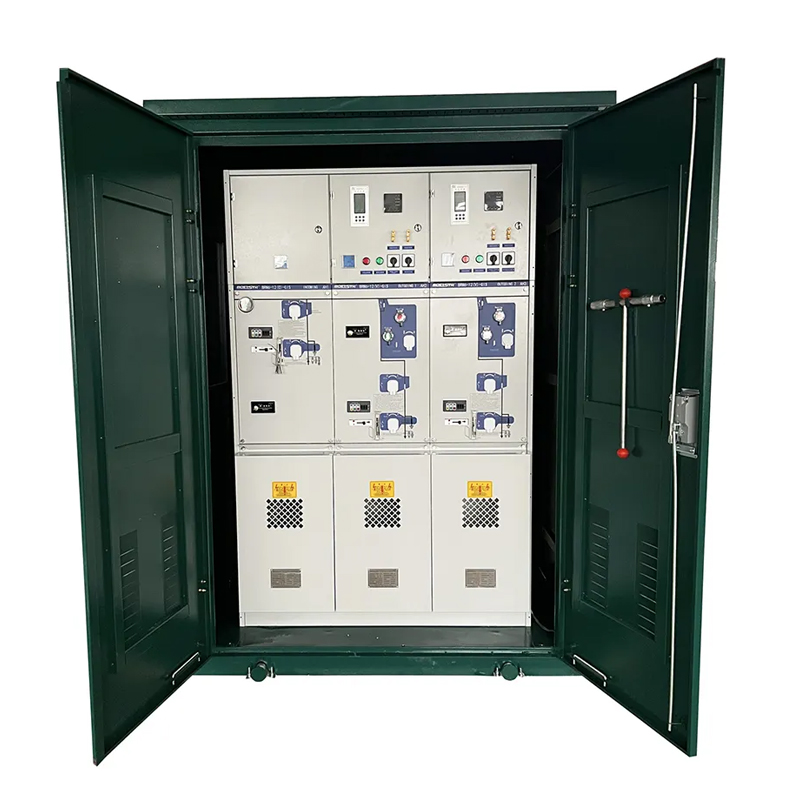
Importance of Designing Airflow Windows and Using Dehumidifiers to Solve Condensation Issues in Outdoor Ring Main Units
Outdoor Ring Main Unit
Outdoor ring main units (RMUs) are often subject to condensation issues due to temperature fluctuations or high humidity. This can negatively impact equipment performance, lead to electrical failures, and cause corrosion of metal components. To effectively address these challenges, designing proper airflow windows and incorporating active dehumidifiers are essential measures. This article provides a detailed discussion on the importance of these two strategies and their practical implementation.

1. Outdoor Ring Main Unit Importance of Airflow Windows
1.1 Improving Air Circulation to Reduce Moisture Accumulation
Airflow windows promote airflow between the interior and exterior of the RMU, significantly reducing moisture buildup:
- Natural Convection: Top and bottom ventilation openings leverage the natural movement of warm air rising and cool air descending to create airflow, expelling moisture effectively.
- Ventilation Exchange: Airflow windows allow drier external air to replace moist internal air, maintaining a dry environment within the RMU.
1.2 Regulating Temperature to Prevent Condensation Formation
Condensation occurs when temperature differences cause water vapor to condense into droplets. Proper ventilation design helps mitigate this by:
- Balancing Temperature: Airflow windows gradually equalize internal and external temperatures, preventing rapid cooling that leads to condensation.
- Controlling Dew Point: Lowering the internal air humidity through ventilation reduces the likelihood of condensation by keeping the temperature above the dew point.
1.3 Protecting Equipment and Extending Service Life
Moisture is a leading cause of electrical failures and metal corrosion. Airflow windows can mitigate these risks by:
- Enhancing Insulation Performance: Reducing moisture on insulating surfaces prevents conductive water films that may cause leakage or short circuits.
- Preventing Metal Corrosion: Expelling moisture slows the oxidation and corrosion of metal components, preserving their integrity.
2.Outdoor Ring Main Unit Dual Protection with Active Dehumidifiers
2.1 Application of Smart Dehumidifiers
In high-humidity or enclosed environments, natural ventilation may not suffice. Active dehumidifiers provide precise humidity control:
- Automatic Humidity Regulation: Smart dehumidifiers, equipped with humidity sensors, automatically activate when humidity exceeds set levels, maintaining an ideal range of 30%-60%.
- High-Efficiency Dehumidification: In consistently humid conditions, such as coastal or rainy areas, dehumidifiers can quickly lower humidity levels to keep the RMU dry.
2.2 Comprehensive Protection with Heating Equipment
- Constant Temperature Heaters: In extremely cold environments, heaters can maintain the internal temperature above the dew point, preventing condensation when dehumidifiers alone are insufficient.
- Temperature and Humidity Integration: Dehumidifiers and heaters can work in tandem to adjust settings dynamically based on real-time conditions, ensuring energy efficiency and optimal protection.
2.3 Superior Performance in Extreme Conditions
- High-Humidity Environments: Active dehumidifiers are indispensable in areas with high ambient humidity, overcoming the limitations of natural ventilation.
- Adaptability to Enclosed Spaces: In RMUs that require minimal ventilation openings for security or environmental reasons, dehumidifiers ensure effective internal humidity control.
3. Outdoor Ring Main Unit Design and Implementation of Airflow Windows
3.1 Positioning and Number of Ventilation Openings
- Top Ventilation Openings
- Positioned to leverage rising warm air, allowing moisture to escape efficiently.
- Equipped with rain covers and dust screens to prevent water and debris intrusion.
- Bottom Ventilation Openings
- Serve as intake points for cooler air, working with top openings to create vertical airflow circulation.
- Side Ventilation Openings
- Symmetrical openings on the RMU’s sides can enhance horizontal airflow.
3.2 Protective Measures for Ventilation Openings
- Dust Filters
- Install fine-mesh dust filters to block dirt and small insects from entering the unit.
- Rain Shields
- Add angled rain shields over openings to prevent water ingress.
- Seal Integrity
- Ensure the edges of ventilation openings are well-sealed to prevent water vapor infiltration.
4.Outdoor Ring Main Unit Maintenance and Precautions
- Regular Cleaning of Ventilation Openings and Dehumidifiers
- Remove dust and debris from ventilation openings to ensure smooth airflow. Inspect and maintain the dehumidifier for optimal performance.
- Check Humidity Sensors
- Ensure the sensors are accurate and responsive to avoid failures in humidity control.
- Replace Aging Components
- Periodically inspect seals, filters, and protective covers for wear and replace them as needed to maintain functionality.
- Monitor Internal Humidity and Temperature
- Use real-time monitoring systems to track environmental conditions inside the RMU and adjust measures accordingly.
